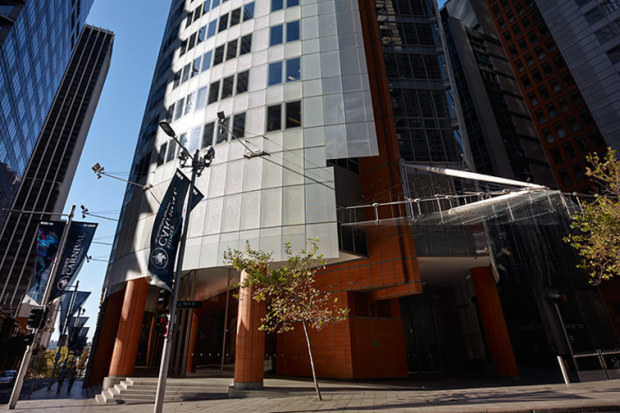Sponsored by Schneider Electric
Smart, green buildings can help construct net zero future
Soaring energy costs have focused the minds of the nation’s captains of industry on the urgent need to decarbonise their bricks-and-mortar empires, new research has revealed.
With 40 per cent of global emissions coming from buildings, our corporate built environment presents low-hanging fruit to combat climate change, while also reducing costs by driving down energy consumption.

40 per cent of global emissions comes from our buildings.
Global power giant Schneider Electric’s Sustainability Index, 2023 report shows that using renewables on site and driving energy efficiency for the nation’s offices, factories, warehouses and other commercial properties is front of mind for the vast majority of the nation’s corporate leaders, with nearly three-quarters saying they have a strategy in place to invest in energy efficiency.
Schneider Electric’s research found that:
- 77 per cent of corporate leaders agree sustainable transformation drives a competitive edge for companies.
- 70 per cent have a strategy in place to invest in energy efficiency.
- 66 per cent have started discussing or have a strategy in place to implement renewable energy solutions on site.
- 78 per cent agree digitisation is playing a key role in achieving sustainability goals.
“The switch to more sustainably efficient buildings has begun, it won’t be achieved overnight, but it is a crucial step to take, particularly for businesses actively trying to achieve their own emissions goals,” says Louise Monger, vice president, digital buildings at Schneider Electric.
“The way Australia designs, constructs, operates and maintains buildings must change rapidly to meet net zero targets.
“Buildings are contributing up to 40 per cent of global emissions, meaning they are a major contributor to the current climate crisis we are trying to tackle. We need to rethink the way we are designing and operating our buildings, and start planning green, smart buildings today, if we are to have any hope of reaching our 2050 net zero target.”
Monger says rising energy costs are a major factor driving Australians and others around the world, to pivot towards smart, green building infrastructure design.

Louise Monger, vice president, digital buildings at Schneider Electric.
“Just like we saw with COVID-19 accelerating Australia’s digital transformation, we are now seeing rising global energy costs having that same impact on sustainability,” says Monger.
“If we are going to achieve net zero, these decisions need to be taken today. It will be challenging and there will be hurdles, however the removal of non-electric sources such as gas from Australian buildings is critical. It’s complex, but the time to start envisioning a generation without dirty power is now.”
Clean electricity
Electricity is a clean energy that can transform the world’s buildings in more ways than one, she says. Electrical heat pumps can be up to four times more efficient as traditional furnaces that run on fossil fuels. Meanwhile, microgrids that run on renewables can power buildings cleanly with greater resiliency.
“Designing buildings to be more efficient also opens opportunities for energy autonomy with microgrids that can help lead to net-zero buildings with a very quick ROI,” says Monger.
“In addition, digital monitoring technology enables building owners and operators to eliminate waste within their buildings by identifying how, why and where waste is happening.”
However, the biggest immediate impact on reducing emissions can come from existing buildings, where retrofits utilising the latest digital technology and monitoring systems can cut energy use by about a third.
“Investing in the modernisation of existing buildings to be more sustainable can transform our cities by significantly reducing energy consumption and waste. Remember, the clear majority of buildings standing in 2050 are buildings that already exist today,” says Monger.
A shining example of a retrofit is the iconic Aurora Place – on the site of the former NSW State Office Block, a 1960s edifice, demolished to make way for the present Renzo Piano-designed tour de force a generation ago.
Schneider Electric and power solutions provider GSTEC have partnered to replace the existing building management system, supporting the building owner’s sustainability requirements and turning the venerable structure into a future-ready smart building.
Joanne Borkowski, building services engineering manager at GSTEC says that changes to the building have driven sustainability, enhanced the property’s smart building capabilities, incorporated connected services and an integrated system platform.
“As an EcoXpert partner for over a decade now, the alliance with Schneider Electric provides us with the back-end support to deliver these major projects and champion buildings of the future,” says Borkowski.
“Together, this gives the customer, tenants and future generations confidence in the building’s longevity.”
Schneider Electric’s industry-unique EcoXpert partner program is a best-practice global ecosystem of expertise. Trained and certified by Schneider Electric, EcoXpert partners digitise and electrify projects for a more sustainable future.
Schneider Electric’s Monger says: “A product can only be as good as the project integrator and we are very grateful to have the opportunity to work with our legacy partner GSTEC. Aurora Place is one of Sydney’s most highly regarded buildings and has maintained the integrity and heart of Renzo Piano’s design.”
Schneider Electric’s research also revealed that the real-estate industry is pivoting from smart buildings to developing smart portfolios for easier aggregation of data to effectively manage a relationship between building owner, manager and occupant.
According to Monger, in addition to real estate the other key sectors set to lead the green charge in the commercial building space are retail and healthcare.
Retail opportunities around IoT
Monger says there is a great opportunity for operators of petrol stations, retail chains, and supermarkets to better understand their environmental footprint and energy usage, particularly with the high traffic these retail spaces have and how widely dispersed premises can be.
“Given the size of Australia and how far and widespread our retail is, retailers need to begin thinking how they can manage and control their assets remotely. Utilising IoT and connected devices has the power to drive efficiency across geographically dispersed portfolios,” says Monger.
Cost savings are a large part of why the retail sector has begun piloting these changes, says Monger.
“Five years ago, the cost of change was a large prohibitor for many companies. Inflation is driving the need for greater operational efficiency and sustainability targets are creating the requirement for sustainability reporting, so the investment in this technology is becoming not just viable but an absolute necessity in Australia.”
Health goes electric
In the healthcare space, Monger says that all-electric hospitals, supported by integrated digital systems will be the biggest enabler to help the industry in the race to net zero.
“We are already seeing a huge shift to sustainability across the healthcare industry, so much so that it is catching up to real estate and other areas that have been on this journey for a considerably longer period of time,” says Monger.
“In the next two years it is essential that healthcare facilities begin to develop strategies for electrification and digitalisation. Not only will this enable more flexibility and resilient services, but technology can be leveraged to improve patient experience as well as staff productivity and sustainability.”
“Electricity will become a much more reliable energy source in the long run, so it is important to make plans now in order to reap the benefits of transitioning away from gas. Investing in innovation will not only bring long-term gains in the healthcare industry but will contribute to the development of a greener future.”
To learn more, download the Sustainability Index, 2023. For more information on the future of digital buildings, please visit Buildings of the Future.
Sponsored by Schneider Electric
Introducing your Newsfeed
Follow the topics, people and companies that matter to you.
Find out moreRead More
Latest In Infrastructure
Fetching latest articles